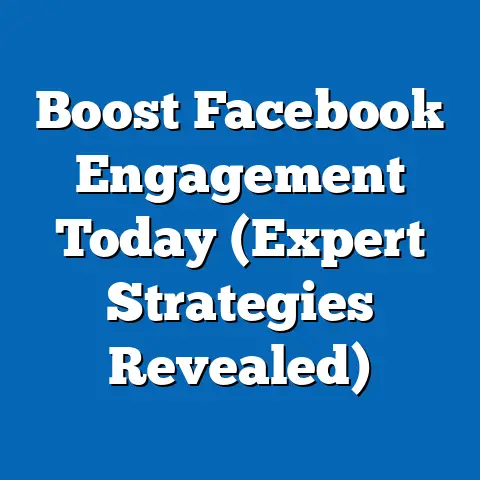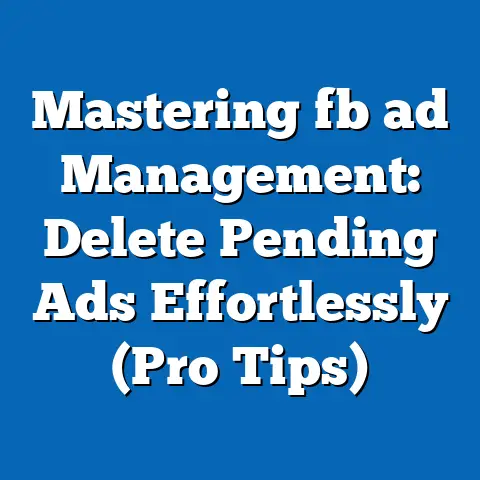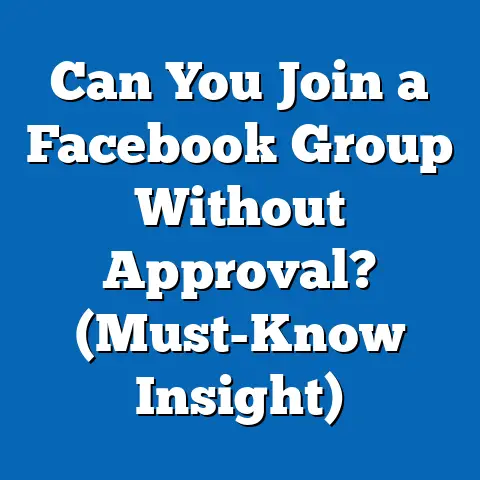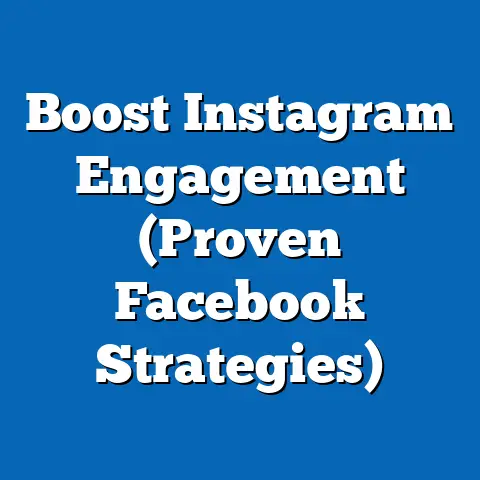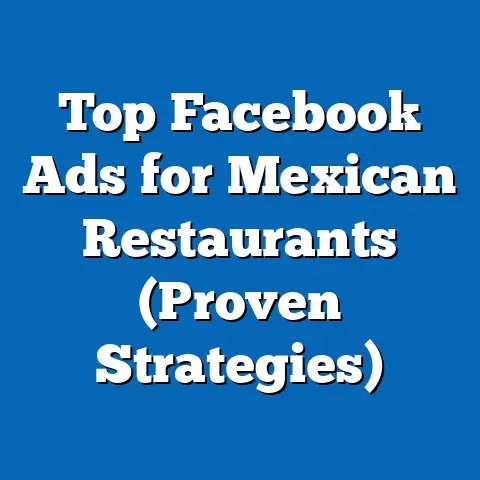Boost Conversions with Powerful fb ad Copy (Proven Strategies)
I remember the first time I truly grasped the power of well-crafted ad copy. I was working with a small e-commerce business struggling to get traction on Facebook. Their products were great, their targeting was decent, but their ads just weren’t clicking. We revamped their ad copy, focusing on benefits over features and weaving in customer testimonials. The result? A 300% increase in conversions within a month. That’s when I realized that Facebook ad copy isn’t just an afterthought; it’s the engine that drives results.
In today’s hyper-competitive digital landscape, mastering the art of writing compelling Facebook ad copy is no longer optional – it’s essential. With millions of businesses vying for attention on the platform, your ads need to cut through the noise and resonate with your target audience on a deeply personal level. Think of it this way: your ad copy is the first handshake, the initial impression, the very reason someone might choose to explore your brand over a competitor.
This guide isn’t just about writing words; it’s about understanding the psychology behind persuasion, the art of storytelling, and the science of optimizing for conversions. I’ll walk you through proven strategies, real-world examples, and actionable tips that you can implement immediately to transform your Facebook ads from bland to brilliant. Let’s dive in and unlock the secrets to crafting ad copy that doesn’t just get clicks, but drives meaningful conversions.
Understanding the Importance of Ad Copy
Ad copy is the unsung hero of successful Facebook advertising. It’s the bridge between your offering and your potential customers, the voice that whispers (or shouts!) the reasons why they should choose you. But why is it so crucial?
The Psychology of Persuasion: At its core, effective ad copy taps into the fundamental principles of human psychology. It leverages emotions, addresses needs, and provides solutions to pain points. Think about it: people don’t buy features; they buy benefits. They buy solutions to their problems, the fulfillment of their desires, and the promise of a better life. Your ad copy needs to articulate these benefits clearly and compellingly.
Consider these psychological triggers that can be incorporated into your copy:
- Scarcity: “Limited-time offer! Only 5 spots left!” Creates a sense of urgency and encourages immediate action.
- Authority: “Trusted by over 10,000 satisfied customers.” Builds credibility and instills confidence.
- Social Proof: “Join the thousands who are already experiencing…” Leverages the power of herd mentality.
- Reciprocity: “Download our free guide and learn…” Offers value upfront, increasing the likelihood of a return favor (a purchase).
The Data Speaks Volumes: Don’t just take my word for it. Studies consistently demonstrate the direct correlation between compelling ad copy and improved conversion rates. For example, a study by Neil Patel found that simply changing a headline resulted in a 40% increase in conversions. Another study by MarketingExperiments showed that focusing on customer benefits in ad copy led to a 30% boost in sales.
Facebook’s Algorithm Loves Engagement: Facebook’s algorithm is designed to reward engaging content. Ads with high click-through rates (CTR), strong engagement (likes, comments, shares), and positive feedback are favored and often receive lower costs per click (CPC) and higher reach. Well-crafted ad copy is the key to driving this engagement. By creating ads that resonate with your audience, you’ll not only improve your conversion rates but also optimize your ad spend.
The Bottom Line: Ad copy is the foundation upon which successful Facebook advertising campaigns are built. It’s the voice of your brand, the messenger of your value proposition, and the catalyst for conversions. Neglecting your ad copy is like building a house on sand – it might look good on the surface, but it won’t stand the test of time.
Key Elements of High-Converting Facebook Ad Copy
Now that we understand the importance of ad copy, let’s break down the essential elements that make it truly effective. These are the building blocks of persuasive messaging, the ingredients that transform words into conversions.
Attention-Grabbing Headlines
Your headline is the first (and sometimes only) chance you have to capture someone’s attention. It’s the hook that lures them in and compels them to read further. A weak headline is like a dull fishing hook – it won’t catch anything.
Key Principles:
- Clarity: Be clear and concise about what your ad is offering. Avoid jargon or overly clever language.
- Benefit-Driven: Focus on the benefits of your product or service, not just the features.
- Urgency: Create a sense of urgency or scarcity to encourage immediate action.
- Intrigue: Spark curiosity and make people want to learn more.
Examples:
- Weak: “New Product Launch!”
- Strong: “Finally! A Solution to [Problem] That Actually Works”
- Weak: “Learn About Our Services”
- Strong: “Double Your Sales in 30 Days with Our Proven Strategy”
Compelling Hooks
The hook is the sentence or two that follows your headline and expands on the initial promise. It’s your opportunity to connect with your audience on a deeper level and demonstrate that you understand their needs and pain points.
Key Principles:
- Identify Pain Points: Address the specific challenges or frustrations that your target audience faces.
- Offer Solutions: Position your product or service as the solution to those pain points.
- Create Empathy: Show that you understand and care about your audience’s struggles.
Examples:
- “Tired of wasting hours on social media with little to no results? We can help.”
- “Struggling to lose weight despite trying every diet under the sun? Our program is different.”
- “Frustrated with complicated software that slows you down? Our solution is simple and intuitive.”
Clear Value Proposition
Your value proposition is the unique benefit that your product or service offers. It’s what sets you apart from the competition and why people should choose you. A strong value proposition is clear, concise, and compelling.
Key Principles:
- Focus on Benefits: Highlight the tangible benefits that your customers will receive.
- Differentiate Yourself: Explain what makes you unique and better than the alternatives.
- Be Specific: Avoid vague or generic statements.
Examples:
- “Our software helps you automate your marketing tasks, saving you time and money.”
- “Our coaching program provides personalized support and guidance to help you achieve your fitness goals.”
- “Our handcrafted jewelry is made with the finest materials and designed to last a lifetime.”
Strong Call to Action (CTA)
Your call to action (CTA) is the final nudge that encourages people to take the desired action. It’s the instruction that tells them what to do next. A strong CTA is clear, concise, and compelling.
Key Principles:
- Use Action Verbs: Start your CTA with a strong action verb, such as “Shop,” “Learn,” “Sign Up,” or “Download.”
- Create Urgency: Use language that creates a sense of urgency, such as “Now,” “Today,” or “Limited Time.”
- Make it Easy: Ensure that the action you’re asking people to take is simple and straightforward.
Examples:
- “Shop Now and Get 20% Off Your First Order!”
- “Learn More About Our Services Today!”
- “Sign Up for Our Free Webinar and Discover…”
- “Download Our Free Guide Now!”
Social Proof and Credibility
People are more likely to trust and believe in brands that have a proven track record of success. Social proof and credibility elements can help you build trust and encourage conversions.
Key Principles:
- Testimonials: Include positive testimonials from satisfied customers.
- Reviews: Showcase positive reviews from reputable sources.
- Statistics: Highlight impressive statistics that demonstrate the effectiveness of your product or service.
- Awards and Recognition: Mention any awards or recognition that your brand has received.
Examples:
- “See What Our Customers Are Saying…” (followed by testimonials)
- “Rated 5 Stars on [Review Platform]”
- “Trusted by Over 10,000 Businesses Worldwide”
- “As Seen On [Media Outlet]”
Takeaway: Master these key elements and you’ll be well on your way to crafting Facebook ad copy that converts. Remember to test different variations and see what resonates best with your target audience.
Proven Strategies for Writing Effective Ad Copy
Now that we’ve covered the fundamental elements, let’s dive into some proven strategies that can take your Facebook ad copy to the next level. These are the techniques that I’ve seen consistently deliver results across various industries and campaigns.
A/B Testing
A/B testing, also known as split testing, is the process of comparing two or more versions of your ad copy to see which one performs better. It’s the scientific method of advertising, and it’s essential for optimizing your campaigns.
Why is A/B Testing Important?
- Data-Driven Decisions: A/B testing allows you to make informed decisions based on real data, rather than relying on guesswork.
- Identify Winning Variations: It helps you identify the specific elements of your ad copy that resonate with your audience.
- Continuous Improvement: It enables you to continuously improve your ad copy over time, leading to better results.
What to Test:
- Headlines: Try different headlines that focus on different benefits or use different language.
- Hooks: Experiment with different hooks that address different pain points or offer different solutions.
- CTAs: Test different CTAs to see which one drives the most clicks and conversions.
- Visuals: Compare different images or videos to see which ones capture the most attention.
How to A/B Test on Facebook:
Facebook’s Ads Manager provides built-in A/B testing capabilities. You can create multiple ad sets with different variations of your ad copy and track their performance.
Takeaway: Make A/B testing a core part of your Facebook advertising strategy. Continuously experiment with different variations of your ad copy to identify what works best for your target audience.
Emotional Triggers
Humans are emotional beings, and our emotions play a significant role in our decision-making process. By tapping into the right emotions, you can create ad copy that resonates with your audience on a deeper level and drives conversions.
Common Emotional Triggers:
- Fear: Highlight potential risks or consequences of not using your product or service.
- Greed: Offer exclusive deals or discounts that create a sense of value.
- Curiosity: Spark curiosity and make people want to learn more.
- Belonging: Emphasize the sense of community or belonging that your brand offers.
- Joy: Create positive emotions and associate your brand with happiness and fulfillment.
Examples:
- Fear: “Don’t let your business fall behind. Get our software today!”
- Greed: “Limited-time offer! Get 50% off your first month.”
- Curiosity: “Discover the secret to [desired outcome].”
- Belonging: “Join our community of [target audience] and connect with like-minded individuals.”
- Joy: “Experience the joy of [benefit] with our product.”
Takeaway: Identify the emotions that resonate with your target audience and use them strategically in your ad copy. Be careful not to be manipulative or unethical.
Using Storytelling
Storytelling is a powerful tool for connecting with your audience on a personal level and creating a lasting impression. Stories are more memorable and engaging than dry facts or figures.
Key Principles:
- Create a Narrative: Craft a compelling narrative that resonates with your audience’s experiences.
- Focus on Characters: Introduce relatable characters that your audience can identify with.
- Highlight the Conflict: Emphasize the challenges or struggles that your characters face.
- Offer a Resolution: Position your product or service as the solution to the conflict.
Examples:
Instead of saying, “Our software is easy to use,” tell a story about a customer who struggled with complicated software and found relief with your product.
Takeaway: Use storytelling to create a deeper connection with your audience and make your ad copy more memorable and engaging.
Personalization
Personalization involves tailoring your ad copy to specific audience segments based on their demographics, interests, or behaviors. It’s about making your ads feel relevant and targeted to each individual.
Benefits of Personalization:
- Increased Relevance: Personalized ads are more likely to resonate with the audience.
- Improved Engagement: They can lead to higher click-through rates and engagement.
- Higher Conversion Rates: They can ultimately drive more conversions.
How to Personalize Your Ad Copy:
- Use Dynamic Text Replacement: Facebook allows you to insert dynamic text based on user data, such as their name or location.
- Create Audience-Specific Ads: Develop different ad copy for different audience segments.
- Target Based on Interests and Behaviors: Use Facebook’s targeting options to reach specific audiences based on their interests and behaviors.
Takeaway: Personalize your ad copy to make it more relevant and engaging for your target audience.
Utilizing FOMO (Fear of Missing Out)
FOMO (Fear of Missing Out) is a powerful psychological trigger that can motivate people to take action. It’s the feeling that you’re missing out on something important or exciting.
How to Leverage FOMO in Your Ad Copy:
- Highlight Limited-Time Offers: Create a sense of urgency by emphasizing that the offer is only available for a limited time.
- Emphasize Scarcity: Highlight the limited availability of your product or service.
- Showcase Social Proof: Demonstrate that other people are already benefiting from your product or service.
Examples:
- “Limited-time offer! Get 20% off your first order before it’s too late.”
- “Only 5 spots left! Sign up for our exclusive workshop now.”
- “Join the thousands who are already experiencing the benefits of [product].”
Takeaway: Leverage FOMO to encourage immediate action and drive conversions.
Incorporating Visuals
While this guide focuses on ad copy, it’s crucial to remember that visuals play a vital role in the overall effectiveness of your Facebook ads. Your ad copy and visuals should work together harmoniously to create a compelling message.
Key Principles:
- Relevance: Choose visuals that are relevant to your ad copy and target audience.
- High Quality: Use high-resolution images or videos that are visually appealing.
- Attention-Grabbing: Select visuals that will capture attention and stand out in the newsfeed.
- Brand Consistency: Ensure that your visuals are consistent with your brand’s overall aesthetic.
Takeaway: Don’t neglect the importance of visuals in your Facebook ads. Choose visuals that complement your ad copy and create a cohesive message.
Case Studies and Real-Life Examples
Let’s take a look at some real-life examples of brands that have successfully implemented these strategies to drive conversions with their Facebook ad copy.
Case Study 1: Dollar Shave Club
Dollar Shave Club is known for their humorous and irreverent ad copy. They use storytelling to connect with their audience and highlight the benefits of their subscription service. Their ads often feature relatable characters and humorous scenarios that resonate with their target audience.
Key Takeaways:
- Use humor to connect with your audience.
- Tell stories that resonate with their experiences.
- Focus on the benefits of your product or service.
Case Study 2: Airbnb
Airbnb uses personalization to target different audience segments with relevant ad copy. They showcase unique and interesting properties in different locations, appealing to travelers with different interests and budgets.
Key Takeaways:
- Personalize your ad copy to target specific audience segments.
- Showcase the unique benefits of your product or service.
- Use high-quality visuals to capture attention.
Case Study 3: HubSpot
HubSpot uses A/B testing to continuously optimize their ad copy. They experiment with different headlines, hooks, and CTAs to see what resonates best with their audience. They also use social proof and credibility elements to build trust and encourage conversions.
Key Takeaways:
- A/B test your ad copy to continuously optimize your campaigns.
- Use social proof and credibility elements to build trust.
- Focus on the benefits of your product or service.
Takeaway: These case studies demonstrate that the strategies outlined in this guide can be successfully implemented across various industries.
Conclusion
Crafting powerful Facebook ad copy that converts is an art and a science. It requires a deep understanding of your target audience, a mastery of persuasive language, and a commitment to continuous optimization.
Remember, your ad copy is the voice of your brand, the messenger of your value proposition, and the catalyst for conversions. Invest time and effort in crafting compelling ad copy that resonates with your audience and drives meaningful results.
Key Takeaways:
- Ad copy is the backbone of effective Facebook advertising.
- Master the key elements of high-converting ad copy: attention-grabbing headlines, compelling hooks, clear value proposition, strong CTAs, and social proof.
- Implement proven strategies such as A/B testing, emotional triggers, storytelling, personalization, and FOMO.
- Continuously optimize your ad copy based on data and insights.
Next Steps:
- Review your existing Facebook ad copy and identify areas for improvement.
- Start A/B testing different variations of your ad copy to see what resonates best with your audience.
- Experiment with different emotional triggers, storytelling techniques, and personalization strategies.
- Track your results and continuously optimize your campaigns.
The world of digital marketing is constantly evolving, but the foundational principles of effective communication remain constant. By mastering the art of writing compelling Facebook ad copy, you can unlock the potential to drive more conversions, build stronger relationships with your audience, and achieve your business goals. Now go forth and create ads that don’t just get clicks, but drive meaningful results!

